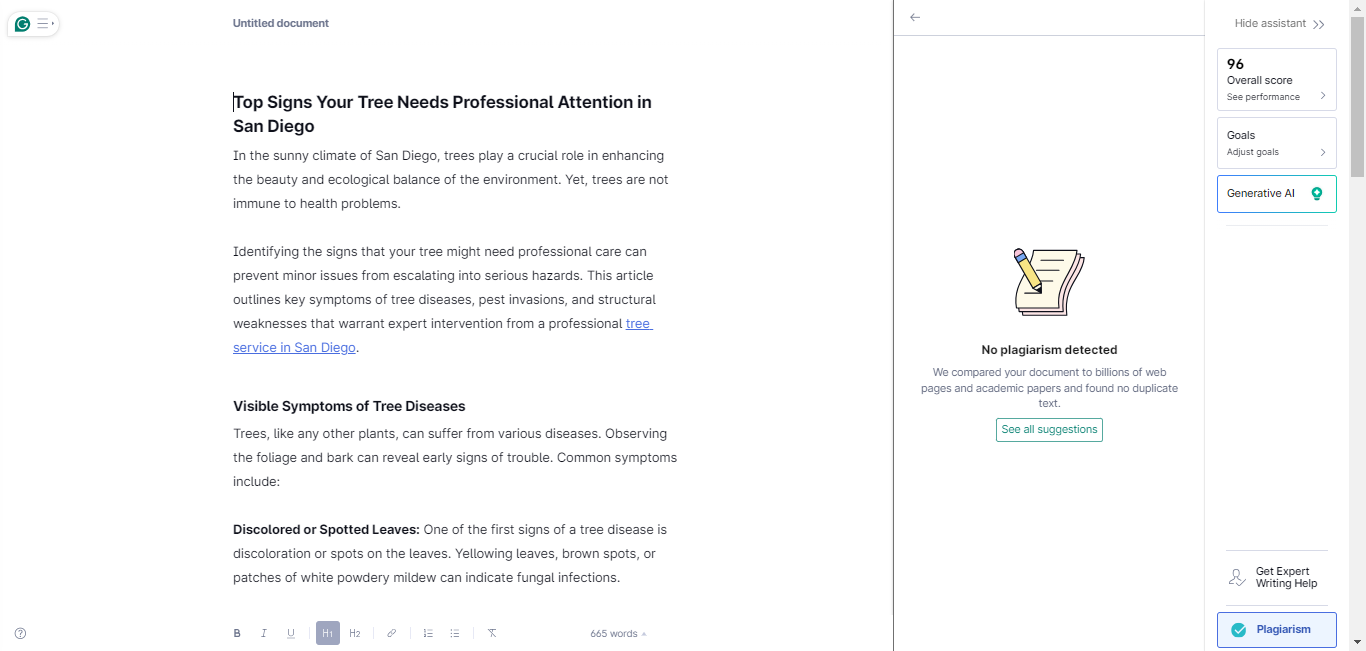Lifestyle
Top Signs Your Tree Needs Professional Attention in San Diego

In the sunny climate of San Diego, trees play a crucial role in enhancing the beauty and ecological balance of the environment. Yet, trees are not immune to health problems.
Identifying the signs that your tree might need professional care can prevent minor issues from escalating into serious hazards. This article outlines key symptoms of tree diseases, pest invasions, and structural weaknesses that warrant expert intervention from a professional tree service San Diego.
Visible Symptoms of Tree Diseases
Trees, like any other plants, can suffer from various diseases. Observing the foliage and bark can reveal early signs of trouble. Common symptoms include:
Discolored or Spotted Leaves: One of the first signs of a tree disease is discoloration or spots on the leaves. Yellowing leaves, brown spots, or patches of white powdery mildew can indicate fungal infections.
Wilting and Premature Leaf Drop: Healthy trees usually maintain their foliage throughout the growing season. Wilting leaves, especially during moist conditions, or premature leaf drop can signal root rot or other serious diseases.
Cankers and Lesions on the Bark: Cankers are dead sections on the bark, often appearing as sunken or discolored areas. They can result from bacterial or fungal infections. Lesions or splits in the bark might also indicate diseases like canker disease, which can compromise the tree’s structural integrity.
Signs of Pest Infestation
Pests are another common threat to the health of trees in San Diego. Insects and other pests can cause significant damage if not controlled promptly. Key indicators include:
Holes and Tunnels in the Bark: Small holes in the bark or sawdust-like material at the base of the tree can be signs of wood-boring insects. Beetles and borers lay their eggs in the tree, and the larvae create extensive networks of tunnels, weakening the tree from the inside.
Chewed or Skeletonized Leaves: If leaves appear chewed or have a skeletonized look (where only the veins are left), it could indicate the presence of caterpillars, beetles, or other leaf-eating insects.
Sticky Residue or Mold Growth: Some pests, like aphids or scale insects, excrete a sticky substance called honeydew, which can lead to the growth of sooty mold on leaves and branches.
Structural Issues and Physical Damage
Apart from diseases and pests, trees can suffer from structural issues or physical damage. Identifying these problems early can prevent accidents and prolong the tree’s life.
Cracked or Split Branches: Cracks or splits in branches or the trunk are significant signs of structural weakness. These can result from storm damage, improper pruning, or internal decay.
Leaning or Unstable Trunk: While some trees naturally grow at an angle, a sudden or increasing lean can indicate root problems or soil instability. Professional assessment is necessary to determine if the tree can be stabilized or if it poses a danger.
Exposed Roots or Soil Erosion: Erosion around the base of a tree can expose roots, making them vulnerable to damage. Exposed roots are less effective at anchoring the tree, leading to instability. Soil erosion can also reduce the nutrients available to the tree, impacting its overall health.
The Importance of Hiring a Professional Tree Service Expert
Hiring a professional tree service in San Diego is crucial for maintaining the health and safety of your trees. These experts possess the knowledge and experience to accurately diagnose and treat diseases, pests, and structural issues. They use specialized tools and techniques to safely trim, prune, and remove trees, minimizing the risk of damage to your property and ensuring the well-being of the tree.
Caring for trees in San Diego requires vigilance and timely intervention. Recognizing the signs of diseases, pests, and structural issues can save trees from irreversible damage. When in doubt, consulting with a professional arborist can provide the necessary care and ensure the safety and beauty of your trees for years to come. Regular inspections and proactive maintenance are key to keeping trees healthy and robust in the diverse climate of San Diego.

Lifestyle
The Unbreakable Bond: Exploring halle jonah close friendship

In a world where connections often come and go, the bond between halle jonah close friendship stands out as a shining example of unwavering friendship. From childhood laughter to navigating adulthood’s challenges, their relationship has flourished over the years. This dynamic duo showcases how true friends can uplift each other through thick and thin. Join us as we delve into the remarkable journey of Halle and Jonah’s close friendship, exploring what makes their connection so special and enduring.
How they have maintained their friendship throughout the years
Halle and Jonah’s friendship is a testament to commitment. They prioritize regular catch-ups, whether through late-night calls or spontaneous weekend adventures. This consistent communication keeps their bond strong.
In an age of social media, they choose meaningful interactions over shallow likes. Their texts are filled with inside jokes and memories that only the two share. These small gestures remind them of their deep connection.
Distance has never been an obstacle for Halle and Jonah. Even when life pulls them in different directions, they make it a point to visit each other whenever possible. Each reunion feels like no time has passed at all.
They also support one another through life’s ups and downs, celebrating successes together while providing comfort during challenging times. This mutual understanding creates a safe space that nurtures their friendship continuously.
Shared experiences and memories
Halle and Jonah have a treasure trove of shared experiences that bind them together. From late-night study sessions to spontaneous road trips, each moment is etched in their memory.
They often reminisce about that unforgettable camping trip when they got lost but discovered a stunning waterfall instead. The laughter, the fear, and ultimately the joy created an unshakable bond.
Their friendship has also been shaped by countless celebrations—birthdays filled with surprises and achievements toasted over dinner. Each milestone celebrated reinforces their connection.
Even during tough times, such as navigating career setbacks or personal challenges, they’ve leaned on one another for support. Those moments served not just as trials but as building blocks for their relationship.
These shared stories create an unbreakable tapestry of trust and understanding between Halle and Jonah. It’s these experiences that remind them why their friendship is so remarkable.
How their friendship has influenced their career paths
Halle and Jonah’s friendship has been a powerful catalyst in shaping their careers. Their unwavering support for each other has opened doors to opportunities that might have remained closed otherwise.
They often collaborate on projects, blending their unique talents. This synergy allows them to create something truly special, whether it be art, music, or film.
Both have inspired each other to take risks. When one faces self-doubt, the other is there with encouragement and perspective. This mutual motivation drives them toward greater heights in their respective fields.
Moreover, they share valuable insights from different industries. These conversations spark innovative ideas that influence their work ethic and creativity.
Halle and Jonah demonstrate how friendships can significantly impact professional journeys while fostering personal growth along the way. Their bond continues to evolve as they navigate the challenges of success together.
Lessons we can learn from Halle and Jonah’s friendship
Halle jonah close friendship teaches us the value of loyalty. They stand by each other through thick and thin. This unwavering support creates a safe space for both to grow.
Communication plays a crucial role in their bond. They share thoughts openly, solving conflicts with ease. This transparency fosters trust, a cornerstone of any strong relationship.
Their ability to celebrate each other’s successes is inspiring. Instead of jealousy, they uplift one another, reinforcing positive energy between them.
Resilience shines through when challenges arise. Halle and Jonah face difficulties together, demonstrating that true friends endure hardships as a team.
Their shared experiences remind us that friendships enrich our lives profoundly. From laughter to tears, each moment shapes who we are and strengthens our connections with others.
The importance of strong friendships in our lives
Strong friendships enrich our lives in countless ways. They provide us with support, comfort, and companionship through life’s ups and downs.
Friends are often the ones who lift us up when we’re feeling down. Their encouragement can be a powerful motivator during tough times. A good friend will always have your back, helping you navigate challenges with care.
Moreover, these relationships foster a sense of belonging. Sharing experiences creates lasting bonds that can define our happiness and well-being.
Friendships also encourage personal growth. Friends inspire each other to pursue dreams and explore new opportunities together.
Strong friendships contribute significantly to mental health by reducing feelings of loneliness and isolation. Knowing that someone truly understands you makes all the difference in navigating life’s complexities.
Conclusion:
The bond between halle jonah close friendship is a testament to the power of friendship. Their journey showcases how commitment, shared experiences, and mutual support can create an unshakeable connection. As they navigate life’s ups and downs together, they demonstrate that strong friendships are not just beneficial but essential.
Their story inspires us all to cherish our own relationships. It reminds us that true friends celebrate our successes and stand by us in challenging times. The lessons learned from Halle and Jonah’s close friendship encourage us to nurture bonds with those who uplift us.
Lifestyle
Tom Ford Sunglasses: Redefining Modern Luxury Eyewear

When it comes to contemporary luxury eyewear, Tom Ford sunglasses are the ultimate statement of sophistication and style. Known worldwide for sleek designs, premium materials, and impeccable craftsmanship, Tom Ford eyewear combines fashion-forward aesthetics with functional excellence. Whether you’re looking to elevate your daily look or invest in long-lasting luxury eyewear, Tom Ford sunglasses provide unmatched quality and timeless appeal.
The Legacy of Tom Ford in Fashion and Eyewear
Tom Ford is synonymous with innovation, elegance, and modern luxury. Since launching his eponymous label in 2005, Ford has brought his expertise in fashion design and attention to detail into every accessory, including eyewear. Each pair of Tom Ford sunglasses reflects the brand’s philosophy of bold sophistication, combining contemporary style with classic craftsmanship.
The use of premium acetate, high-grade metals, and scratch-resistant lenses ensures that each pair not only looks stunning but also performs exceptionally. Subtle branding, signature detailing on temples, and ergonomic design make Tom Ford sunglasses a symbol of refined luxury that enhances any wardrobe.
Why Choose Tom Ford Sunglasses?
Investing in Tom Ford sunglasses is about more than aesthetics—it’s about quality, comfort, and style. Here’s why these sunglasses stand out:
- Fashion-Forward Designs: Tom Ford eyewear features bold shapes, sleek lines, and modern silhouettes that complement a variety of face shapes.
- Premium Materials: Crafted from high-quality acetate and metal, Tom Ford sunglasses provide durability and a luxurious feel.
- UV Protection: Lenses are designed to block harmful UVA and UVB rays, ensuring maximum eye safety without compromising style.
- Distinctive Branding: Subtle yet iconic details, such as the signature “T” on temples, add a touch of exclusivity to each frame.
- Versatility: Suitable for casual outings, formal events, or stylish daily wear, Tom Ford sunglasses elevate any ensemble.
By choosing Tom Ford, you’re investing in eyewear that balances functionality, fashion, and long-lasting elegance.
Exploring the Tom Ford Sunglasses Collection
Tom Ford offers a diverse range of styles, catering to different tastes and fashion preferences. Popular options include:
- Aviator Frames: Sleek and timeless, aviators are ideal for creating a professional yet stylish look.
- Square Frames: Bold square frames project confidence and are perfect for formal and casual wear.
- Cat-Eye Designs: Elegant and feminine, cat-eye frames add sophistication to any outfit.
- Round and Oversized Frames: Retro-inspired shapes bring versatility and glamour, complementing both casual and dressy attire.
Each pair of Tom Ford sunglasses is designed with comfort and ergonomics in mind, ensuring that they look great while providing a secure and comfortable fit for all-day wear.
Styling Tips for Tom Ford Sunglasses
Tom Ford eyewear isn’t just about functionality—it’s a fashion statement. Here’s how to style them effectively:
- Professional Settings: Square or rectangular frames pair well with suits, blazers, and office attire, enhancing sophistication.
- Casual Outfits: Aviators, round frames, or cat-eye sunglasses complement jeans, casual dresses, and relaxed ensembles effortlessly.
- Accessory Pairing: Coordinate your sunglasses with other accessories like watches, bags, or belts to achieve a cohesive luxury look.
- Seasonal Selections: Lighter or pastel frames for summer and darker frames for winter allow you to match eyewear with seasonal fashion trends.
By following these tips, Tom Ford sunglasses become a versatile accessory that elevates your style while providing practical sun protection.
The Value of Investing in Luxury Sunglasses
High-quality luxury sunglasses are more than a fashion accessory—they’re an investment in eye health, durability, and personal style. Premium sunglasses like Tom Ford protect eyes from harmful UV rays, reduce glare, and enhance vision clarity.
Unlike mass-produced eyewear, luxury brands focus on precision engineering, ergonomics, and long-lasting aesthetics. Owning Tom Ford sunglasses not only signals refined taste but also ensures a combination of comfort, style, and long-term value.
Why Shop Tom Ford Sunglasses at Turakhia Eyewear
To guarantee authenticity and access to the latest collections, Tom Ford sunglasses should be purchased from trusted retailers like Turakhia Eyewear. Advantages include:
- Authenticity Guarantee: Every pair of Tom Ford sunglasses is certified genuine.
- Wide Collection: Access to contemporary and classic eyewear styles, including exclusive releases.
- Expert Assistance: Guidance from trained staff to select the perfect frame for your face shape and style.
- Convenient Shopping: Smooth online experience with reliable shipping and support.
Turakhia Eyewear ensures that your purchase of Tom Ford sunglasses and luxury sunglasses is authentic, stylish, and a worthwhile investment.
Conclusion
For individuals seeking modern elegance, functionality, and prestige, Tom Ford sunglasses are the ultimate choice. With their innovative designs, premium materials, and attention to detail, Tom Ford eyewear elevates both casual and formal looks.
Owning luxury sunglasses from Tom Ford ensures that you protect your eyes without compromising on style. Explore the collection at Turakhia Eyewear to invest in eyewear that combines fashion, comfort, and sophistication—a true symbol of modern luxury.
Lifestyle
Sinkom Success Stories: How Bloggers are Thriving on This Innovative Platform

Introduction to Sinkom and its Features
In the ever-evolving world of blogging, finding the right platform can make all the difference. Enter Sinkom—a game-changer for bloggers looking to carve out their niche and connect with audiences. With its unique features tailored to enhance creativity and engagement, Sinkom is fast becoming a favorite among content creators.
What sets it apart? From user-friendly interfaces to robust analytics tools, this innovative platform is designed not just for writing but for thriving. Bloggers are discovering new ways to monetize their passion while building meaningful connections with readers. Let’s dive into some inspiring success stories that showcase how individuals are making waves on Sinkom and taking their blogging journeys to unprecedented heights.
The Power of Blogging on Sinkom
Blogging on Sinkom opens doors to endless possibilities. This platform is designed with creators in mind, making it easy to share your passion and connect with an audience.
The user-friendly interface helps bloggers focus on what they do best: writing. With customizable templates, you can create a visually appealing site that reflects your unique style.
Sinkom also offers robust analytics tools. These insights allow you to track engagement and understand your audience better. You can refine your content strategy based on actual data rather than guesswork.
Moreover, networking opportunities abound within the Sinkom community. Engaging with fellow bloggers fosters collaboration and idea-sharing, enriching everyone involved.
By leveraging these features, bloggers have found their voices amplified like never before. Whether you’re a seasoned writer or just starting out, Sinkom provides the support needed for creative growth.
Success Story #1: Blogger X’s Journey to Monetizing Their Passion
Blogger X began their journey on Sinkom with a simple goal: to share their love for travel. With vivid storytelling and stunning photography, they quickly captured the hearts of readers.
Using Sinkom’s unique features, Blogger X found ways to engage more deeply with their audience. They utilized interactive polls and captivating visuals that made every post stand out.
After gaining traction, monetization became a focus. Through sponsored posts and affiliate marketing links integrated seamlessly into their content, they turned passion into profit.
The support from the Sinkom community was invaluable during this transition. Fellow bloggers offered tips while engaging followers boosted visibility.
Today, Blogger X thrives as not just a creator but also an influencer in the travel niche, proving that dedication paired with the right platform can lead to remarkable success stories like theirs.
Success Story #2: How Sinkom Helped Blogger Y Grow Their Audience
Blogger Y had a passion for travel and a desire to share their adventures with the world. However, building an audience proved challenging on traditional platforms. They needed something different.
Enter Sinkom. This innovative platform offered unique tools tailored for bloggers aiming to grow their reach. With its user-friendly interface, Blogger Y quickly adapted and began crafting captivating posts that resonated with readers.
Utilizing Sinkom’s community features, they connected with like-minded individuals who shared similar interests. Engaging in discussions helped them refine their content while boosting visibility.
Additionally, SEO optimization tools available through Sinkom made it easier for Blogger Y’s articles to rank higher in search results. As traffic surged, so did engagement levels—comments and shares multiplied.
Before long, what started as a modest blog transformed into a vibrant online community filled with enthusiastic followers eager for more of Blogger Y’s adventures.
Tips for Bloggers Looking to Succeed on Sinkom
To thrive on Sinkom, focus on your niche. Identify what sets you apart and center your content around it.
Engagement is key. Interact with your audience through comments, polls, or social media shares. This builds a community that supports you.
Utilize the platform’s features fully. Explore tools for SEO optimization, analytics, and promotional opportunities to enhance visibility.
Consistency matters too. Create a posting schedule that keeps your readers coming back for more while maintaining quality in each piece you publish.
Don’t hesitate to collaborate with other bloggers. Partnering can introduce you to new audiences and inspire fresh ideas within your work.
Keep learning about trends in blogging and digital marketing. Adapting to changes ensures you’re always ahead of the curve on Sinkom.
Conclusion: Why Sinkom is the Platform for Bloggers to Thrive
Sinkom stands out as a powerful platform for bloggers seeking to elevate their online presence. Its innovative features help streamline the blogging process, making it easier to create engaging content and connect with audiences. The success stories of Blogger X and Blogger Y illustrate how effective this platform can be when it comes to monetization and audience growth.
What sets Sinkom apart is its supportive community and user-friendly design. Bloggers on Sinkom have access to tools that enhance visibility, foster engagement, and simplify monetization strategies. As more creators join the platform, they benefit not only from advanced features but also from shared experiences within a collaborative environment.
For anyone looking to make their mark in the blogging world, Sinkom offers unique advantages that can’t be overlooked. Embracing this innovative platform might just be the key ingredient for your blogging success story too.
-

 GENERAL2 years ago
GENERAL2 years agoDiscovering the Artistic Brilliance of Derpixon: A Deep Dive into their Animation and Illustration
-

 Posts2 years ago
Posts2 years agoSiegel, Cooper & Co.
-

 HEALTH2 years ago
HEALTH2 years agoTransformative Health Solutions: Unveiling the Breakthroughs of 10x Health
-

 Lifestyle2 years ago
Lifestyle2 years agoPurenudism.com: Unveiling the Beauty of Naturist Lifestyle
-

 FASHION2 years ago
FASHION2 years agoThe Many Faces of “λιβαισ”: A Comprehensive Guide to its Symbolism in Different Cultures
-

 Lifestyle2 years ago
Lifestyle2 years agoBaddieHub: Unleashing Confidence and Style in the Ultimate Gathering Spot for the Baddie Lifestyle
-

 Entertainment2 years ago
Entertainment2 years agoGeekzilla Podcast: Navigating the World of Pop Culture, Gaming, and Tech
-

 Lifestyle1 year ago
Lifestyle1 year agoSandra orlow: Unraveling the Story of an Iconic Figure
